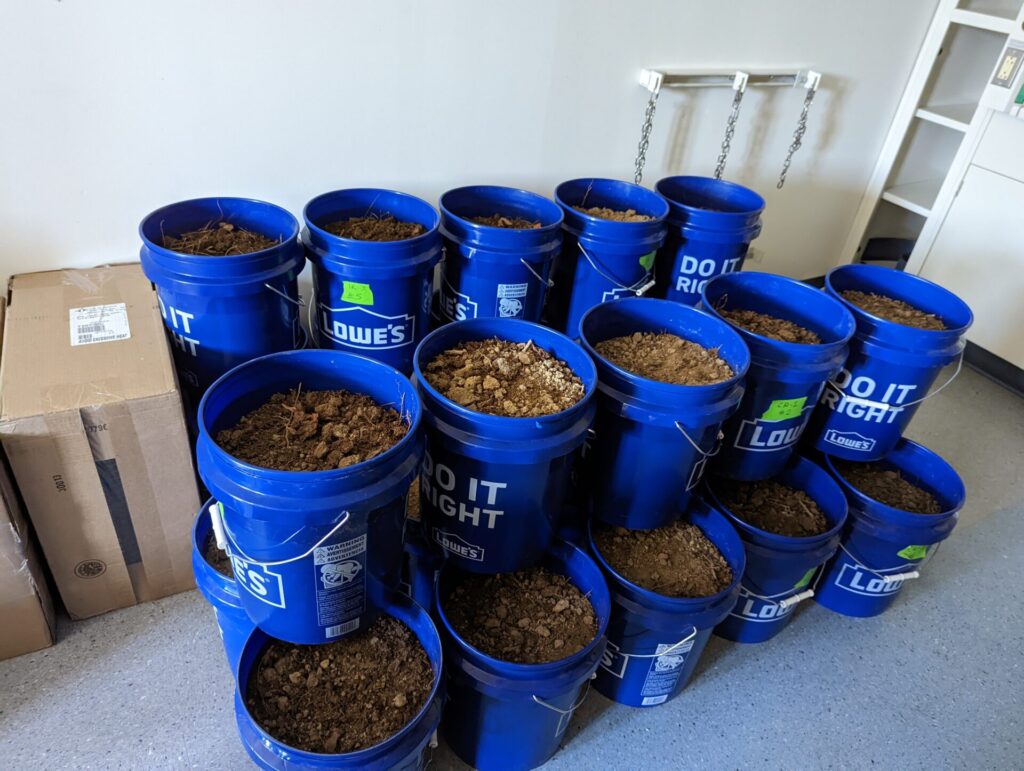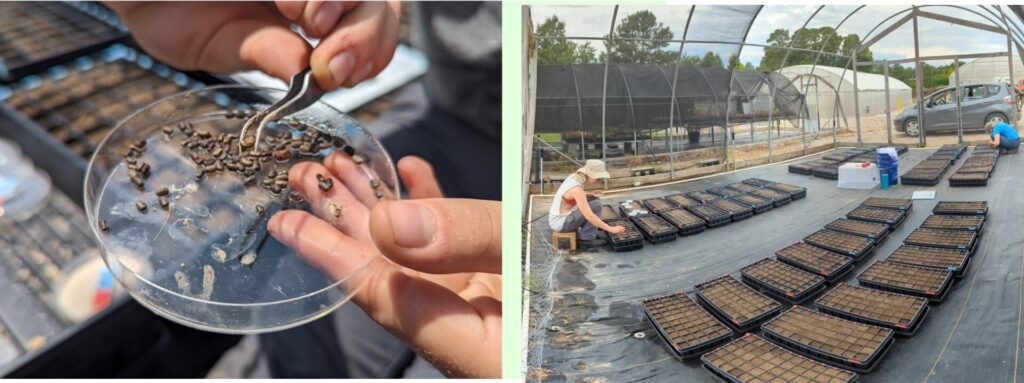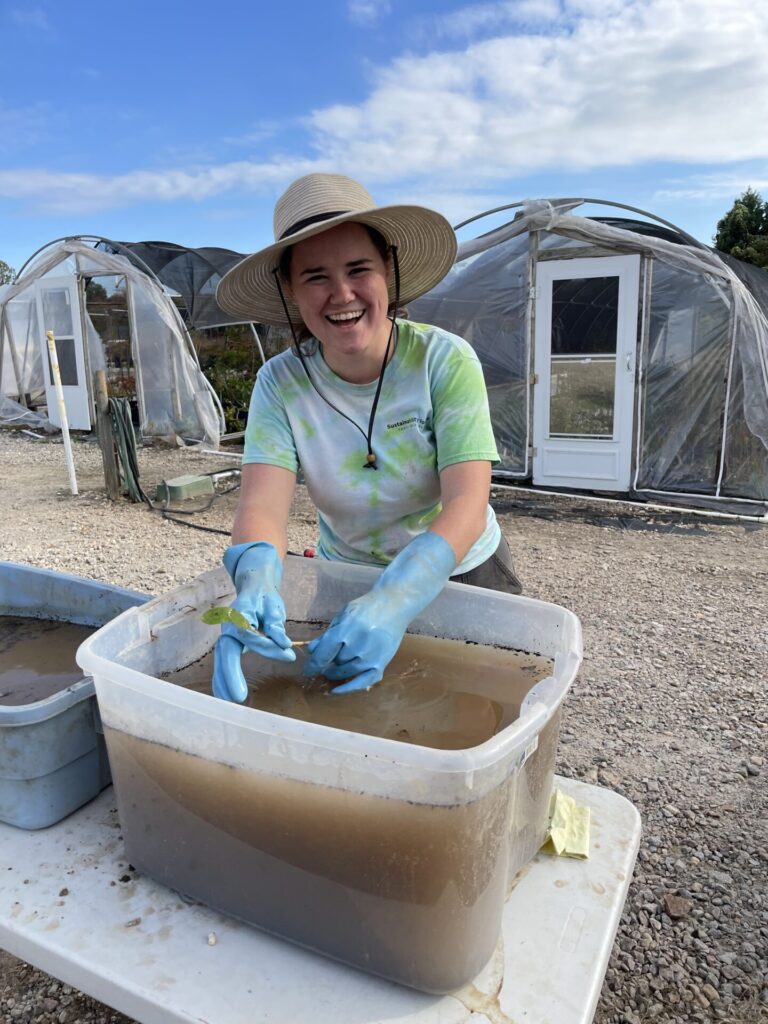By Erin Eichenberger, 2023 Shinn Grant Recipient
The native grassland community of central North Carolina is vanishingly rare, persisting primarily in the curious undeveloped margins of the built environment including, like roadsides and rights-of-way. These “Piedmont prairie” remnants house some of our state’s rarest plant species, including the federally listed Smooth Coneflower (Echinacea laevigata) and Schweinitz’s Sunflower (Helianthus schweinitzii.) However, these remnant communities are imperiled by the press of urban development, the routine danger of herbicide and brush cutting for civil maintenance, and the march of climate change.
A Shinn grant helps
These rare species need safer harbors to persist. They will benefit as well from research supporting best practices for restoration efforts. With support of a Shinn Grant from the North Carolina Native Plant Society, I set out to investigate which environmental factors promote germination and the establishment of more common species—the first steps to cultivating a thriving prairie community that includes common and rare plants.
The primary goal of my research was to explore the role of soil in prairie community growth. My study area falls within a Triassic Basin, a geologic rift formed when Pangea broke apart. At particularly thin points in the Earth’s crust, magma reached the surface and cooled to form an igneous bedrock called diabase. Soils that arise from weathered diabase have different chemical and physical properties than those from the surrounding conglomerate bedrock. Remnants of Piedmont prairie communities are found frequently on these diabase-derived soils, which may indicate that prairie species adapted to the soils’ distinctive properties.
However, these same properties are undesirable for agriculture; therefore, there is a disproportionate amount of unplowed diabase-derived soil in our highly disturbed Piedmont region. The plow is one of the greatest enemies of grassland communities; plowing turns over soils, which disrupts seedbanks, root systems, and available nutrients. Where scraps of land escape the plow, remnant grassland communities thrive. It may be that the prairie’s modern association with diabase-derived soils is an artifact of the non-random selection of sites for farming and urban development.
The experiment begins
In order to test whether prairie-affiliated species are actually suited to growing on diabase-derived soils, I designed an experiment to grow eight species of plants commonly found in Piedmont prairie remnants on two kinds of soil. In a controlled growing environment, I could stress-test my seedlings by varying the levels of light and water I gave them and observe whether some combination of soil, water and light increased germination, survival and growth of seedlings.
To work on my hypotheses about the influence of soil on prairie seedlings, I first needed a lot of soil. An overcast day in April 2022 found me panting and heaving shovelfuls of rich, dark topsoil from an unplowed tract of land overlying diabase bedrock. One of the fascinating properties of this soil series (locally called “Butner gumbo” and classified as the Iredell series by scientists) is its capacity to retain water. It hadn’t rained in a few days, so I hoped the soil wouldn’t be too heavy; waiting too long would mean the soil would harden, crack to a bricklike crust, and require all my strength to shovel.
Luckily, I was on the safe side of needing to break out a pickaxe; but the soil was heavy, the cobble plentiful, and my past childhood experience in digging was restricted entirely to yard work. Fifteen five-gallon bucketfuls came slowly but surely, and by the end of the day I drove back to NC State University with more than half of the hardest work done (and the blisters to prove it.)

I returned to the field with a second shovel and a helper to collect the second soil I would be testing, the Creedmoor series, which also occurs in my study area but there, it is weathered from conglomerate Triassic Basin material with a chemical composition more commonly found in soils throughout the Piedmont. This new area of the Creedmooor series soil was much easier to dig. Together, we made quick work of the next 15 buckets.
Iredell and Creedmoor soils
The two soil series, Iredell and Creedmoor, formed the foundation of my experiment and my seedlings’ growing medium. Over the course of three days at the NC State Horticultural Field Laboratory, using our collected soils, we sowed over 15,000 seeds from eight grassland-affiliated species.

We varied the amounts of light and water to give the seedlings by using shade cloth and supplemental water to test whether Iredell soil might increase seedling resilience to environmental stressors. With two kinds of soil, two levels of sun exposure, and two watering regimes, we had eight experimental treatments that we applied to eight species for a total of 64 species and treatment combinations!
I visited my seedling nursery almost daily from the June planting to the first frost in October, with weekly censuses to track plants as they germinated and died. As the growing season wound down, so, too, did the lives of my teeny plants (though a handful of Indiangrass [Sorghastrum nutans] seedlings shot up to over three feet tall!). We first removed single leaves from every living plant, which we weighed, imaged, and bagged for transport back to the lab. To do this, we built a mini field lab out of folding tables, jeweler’s scales, flatbed scanners, and laptops. Not only did we have to constantly anchor the mini lab, which was imperiled by the October winds, but we had to break it down periodically and move it out of the hoop house to save the electronics from the automatic sprinklers. Collecting this data in the field was laborious, but it allowed us to precisely measure the size of the leaves before any shriveling or drying could occur.
The next step was to harvest the seedlings to measure the total mass of tissue produced through the growing season. We carefully removed individual plants from the tray and washed the soil away from the roots while keeping our elbows in water that was just a few degrees above freezing. After patting the roots dry, we separated leaves and stems from the roots and bagged everything up.

All of this material was destined for drying ovens on campus at NCSU. The final piece of data collection was to weigh each individual sample. We had almost 1400 plants alive at the end of the growing season, most of which had three tissue samples—single leaf, above-ground, and below-ground; and, we had over 4000 samples to organize, weigh and double-check. With this data in hand, I could finally begin analyzing whether hauling hundreds of pounds of soil around had been worth it.
Most species’ seeds germinated best on prairie-associated Iredell soil. Upon germination, most seedlings tended to survive to October—though a hot, dry week in July took a significant toll on my Prairie-dock (Silphium terebinthinaceum) seedlings. Prairie-dock seedlings that grow on prairie soil, however, were more resilient to the drought and survived in greater numbers, just as I had expected. Though responses varied across species, most species grew largest on prairie soils, which seemed to offset the challenges of growing in full sun and with limited water. Seedlings of all species grew less root mass and more shoot and leaf mass on prairie soils even when exposed to desiccating full-sun conditions, suggesting that this soil’s ability to retain water offset the need for more roots. This was particularly important in three species that flowered in the first year—Common Sensitive-plant (Chamaecrista nictitans), Spurred Butterfly Pea (Centrosema virginianum), and Hairy Witchgrass (Panicum capillare)—as seedlings growing on prairie soil were able to invest more resources in reproduction than survival.

This rich dataset I have developed offers other exciting avenues for me to pursue. One avenue would be to explore how plants invested in different survival strategies, and whether investment shifted across treatments. That flowering was more common in some seedlings suggests that differential resource investment occurred, which I will be able to explore further by analyzing the fresh leaf surface area and mass data we collected in the mini lab.
More prairie habitats, please
As the Piedmont of North Carolina rapidly urbanizes, it becomes increasingly urgent to conserve extant prairie remnants and establish new restorations. Diabase-derived soils like the Iredell series I worked with are relatively rare in our region. Conserving pockets of land where they occur may be key for preserving prime prairie habitat. However, the fact that each of my study species that established on rarer Iredell soil also grew on more common Creedmoor soil—though frequently in lower numbers—suggests that there is great promise in establishing restorations on a wider range of soils. Fortunately, there is growing public interest in restoring “Piedmont prairie” habitat, with organizations including the North Carolina Museum of Art’s cultivating plantings of sun-loving native species. As I continue to analyze the results of my experiment, I hope to develop recommendations for land managers and hobbyists alike to aid in growing prairie plants.
By Erin Eichenberger
Native Plant News – Spring 2024

Erin Eichenberger is a PhD candidate at North Carolina State University. She earned her BS in Biology and Environmental Science at the College of William and Mary in 2019. Her dissertation work investigates the ecology of native plants and pollinators in the North Carolina Piedmont.
Editor’s Note: More people today want to help restore prairie habitats. In this article, Erin Eichenberger, a Shinn Fund recipient, investigates and explains what can help prairie wildflowers thrive in North Carolina. Read Erin Eichenberger’s research report here. Each year the NCNPS Shinn Fund provides support to students to research native plants and habitats. – Andrea Thunem, editor, Native Plant News.

